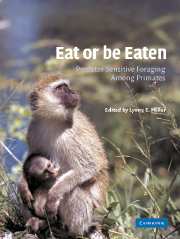Book contents
- Frontmatter
- Contents
- List of contributors
- Preface
- 1 An introduction to predator sensitive foraging
- PART I BIOLOGICAL VARIABLES
- PART II SOCIAL VARIABLES
- 6 The role of group size in predator sensitive foraging decisions for wedge-capped capuchin monkeys (Cebus olivaceus)
- 7 Group size effects on predation sensitive foraging in wild ring-tailed lemurs (Lemur catta)
- 8 Species differences in feeding in Milne Edward's sifakas (Propithecus diadema edwardsi), rufus lemurs (Eulemur fulvus rufus), and red-bellied lemurs (Eulemur rubiventer) in southern Madagascar: Implications for predator avoidance
- 9 Evidence of predator sensitive foraging and traveling in single- and mixed-species tamarin troops
- 10 Predator (in)sensitive foraging in sympatric female vervets (Cercopithecus aethiops) and patas monkeys (Erythrocebus patas): A test of ecological models of group dispersion
- 11 Predation risk and antipredator adaptations in whitefaced sakis, Pithecia pithecia
- PART III ENVIRONMENTAL VARIABLES
- Index
7 - Group size effects on predation sensitive foraging in wild ring-tailed lemurs (Lemur catta)
Published online by Cambridge University Press: 10 November 2009
- Frontmatter
- Contents
- List of contributors
- Preface
- 1 An introduction to predator sensitive foraging
- PART I BIOLOGICAL VARIABLES
- PART II SOCIAL VARIABLES
- 6 The role of group size in predator sensitive foraging decisions for wedge-capped capuchin monkeys (Cebus olivaceus)
- 7 Group size effects on predation sensitive foraging in wild ring-tailed lemurs (Lemur catta)
- 8 Species differences in feeding in Milne Edward's sifakas (Propithecus diadema edwardsi), rufus lemurs (Eulemur fulvus rufus), and red-bellied lemurs (Eulemur rubiventer) in southern Madagascar: Implications for predator avoidance
- 9 Evidence of predator sensitive foraging and traveling in single- and mixed-species tamarin troops
- 10 Predator (in)sensitive foraging in sympatric female vervets (Cercopithecus aethiops) and patas monkeys (Erythrocebus patas): A test of ecological models of group dispersion
- 11 Predation risk and antipredator adaptations in whitefaced sakis, Pithecia pithecia
- PART III ENVIRONMENTAL VARIABLES
- Index
Summary
Introduction
Models that seek to address the costs and benefits of social groupliving often posit resource competition as one disadvantage of social living (Alexander 1974, Janson and Goldsmith 1993, Terborgh and Janson 1986, van Schaik 1983, van Schaik and van Hooff 1983, Wrangham, 1980). Such models differ in the importance of interversus intragroup competition, and on what factors encourage individuals to tolerate living in larger groups. ‘Predation–intragroup feeding competition’ models (PFC) (Alexander 1974, Terborgh and Janson 1986, van Schaik 1983, van Schaik and van Hooff 1983) all focus on intragroup feeding competition as the ultimate cost for group living, which intensifies as group size increases. For such models, increased predator detection and hence a reduction in predator risk is the driving force behind larger groups, and group size fluctuates as a response to these two factors. Indeed, van Schaik (1983: p. 138) has posited, ‘group living is disadvantageous with respect to feeding and that the avoidance of predation confers the only universal selective advantage of group living in diurnal primates.’ There have been few direct tests of the PFC model for primates, but larger groups of wild long-tailed macaques were better at predator detection (van Schaik et al. 1983) and smaller groups of yellow baboons did exhibit behaviors more conducive to monitoring predators or predator escape (Stacey 1986). It is clear, however, that there is no simple relationship between predation and group size (Boinski and Chapman 1995, Treves 1999). As such, there is a need for more specific quantitative analyses to determine the relationship between group size and predator pressure.
- Type
- Chapter
- Information
- Eat or be EatenPredator Sensitive Foraging Among Primates, pp. 107 - 125Publisher: Cambridge University PressPrint publication year: 2002
- 17
- Cited by



